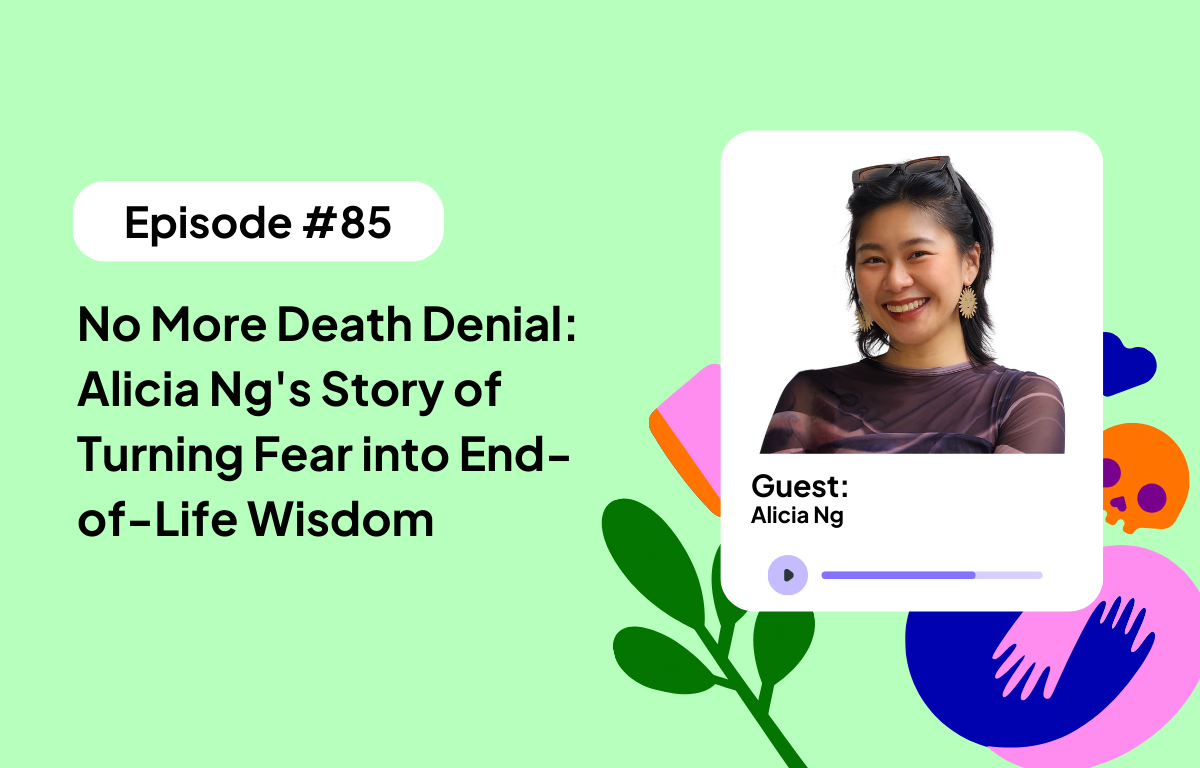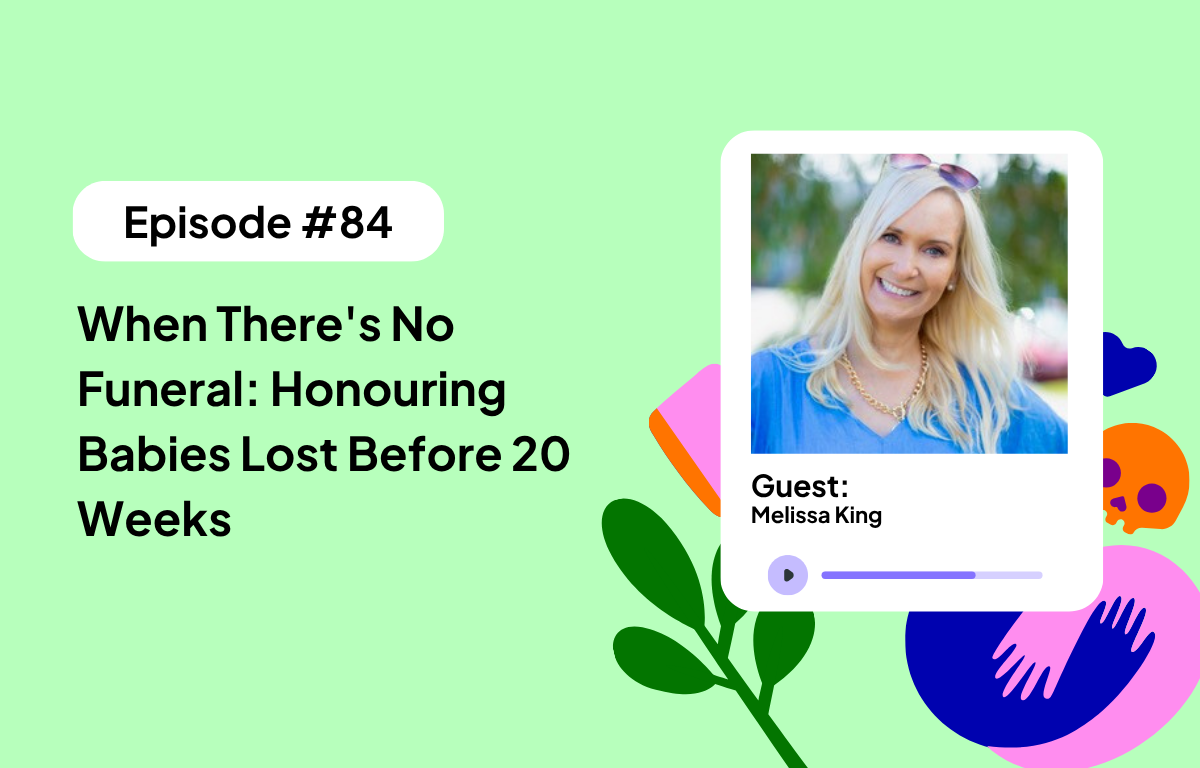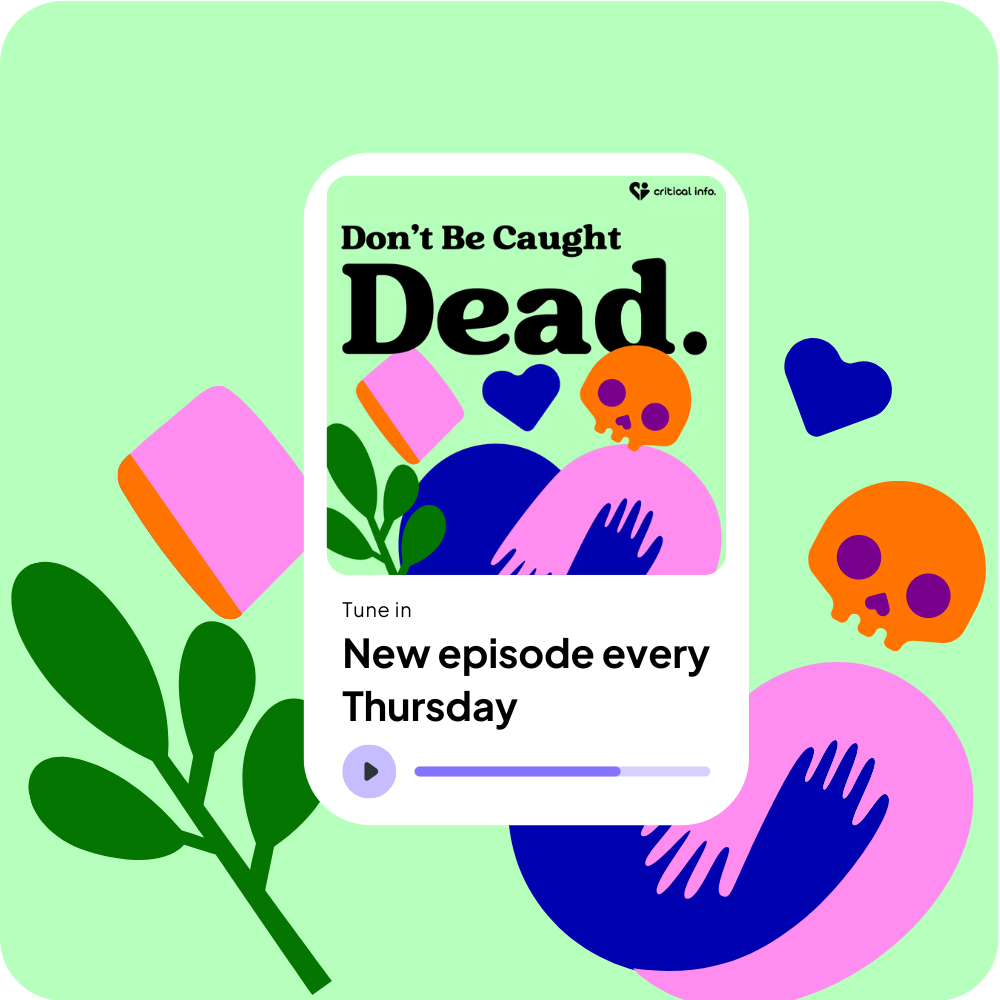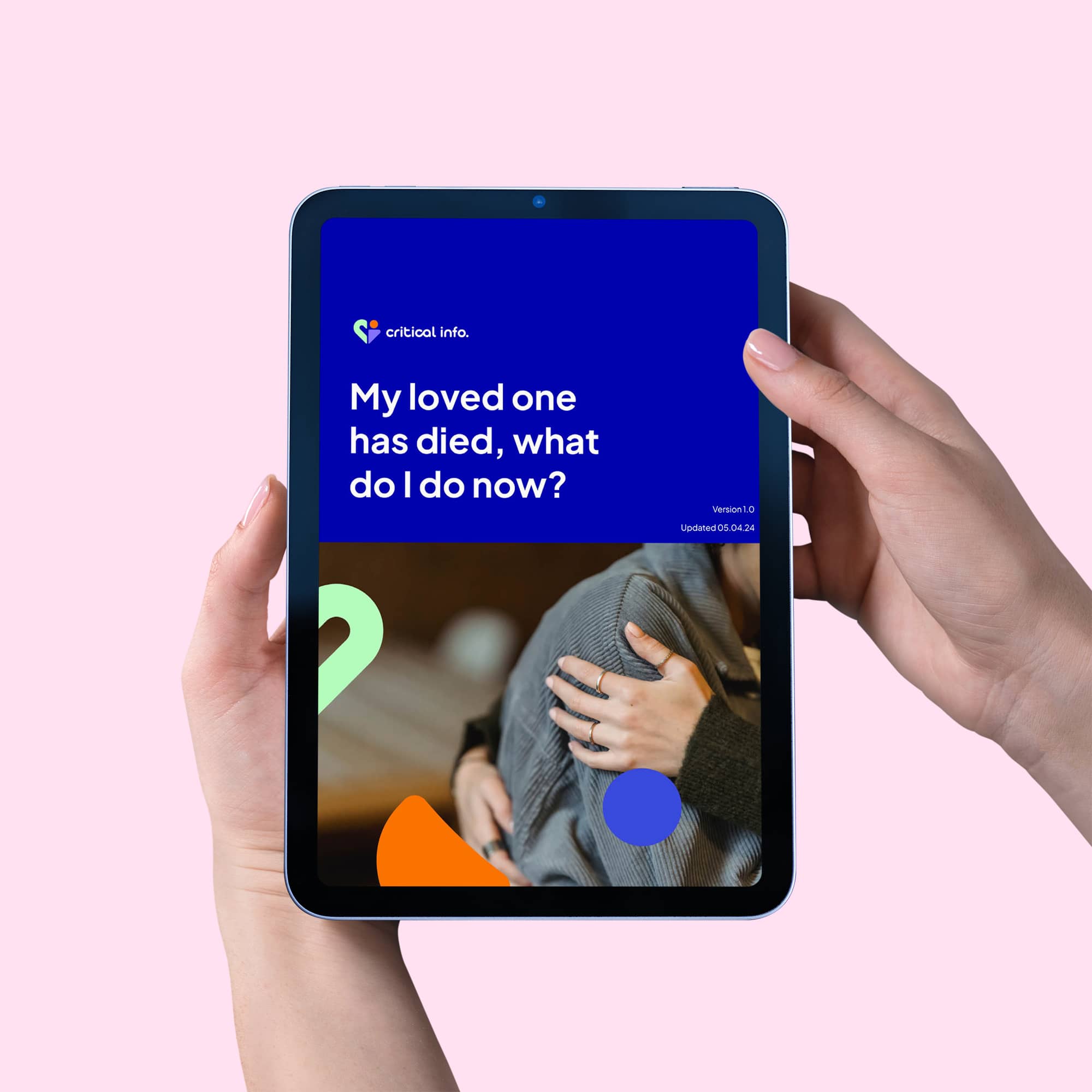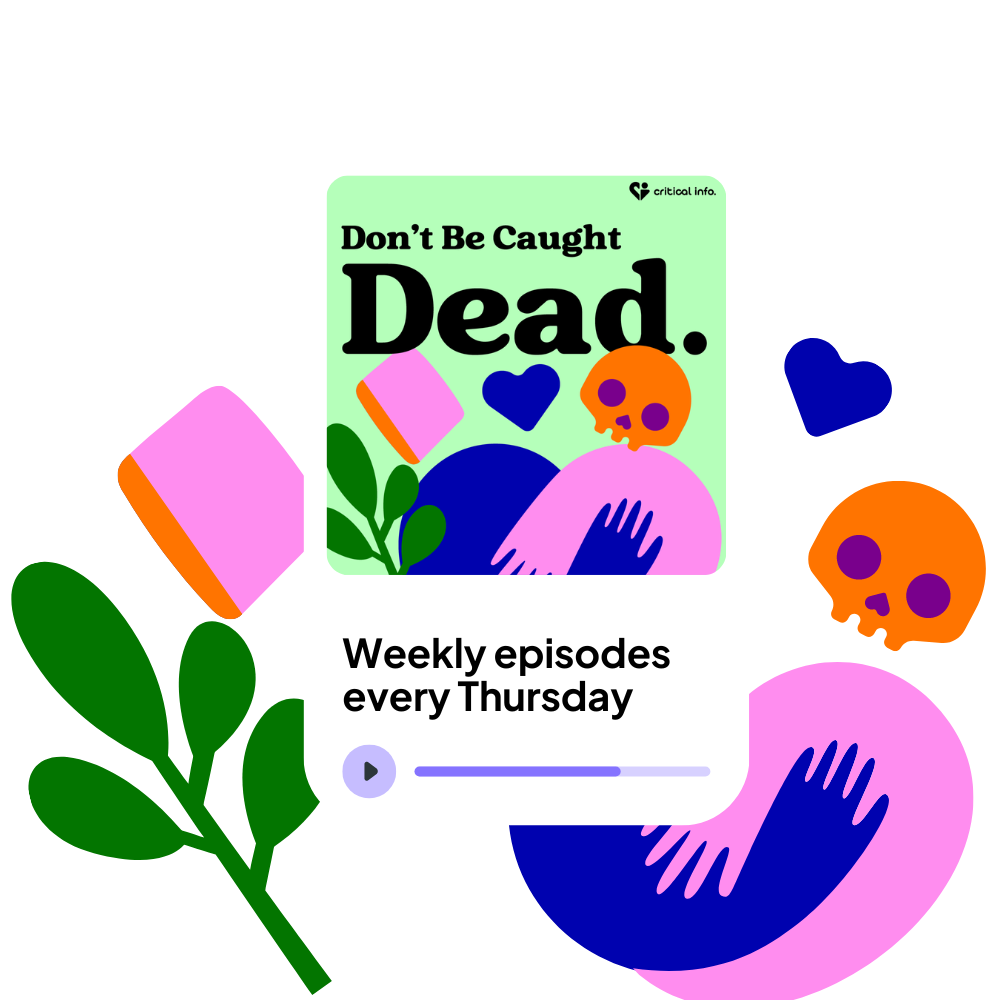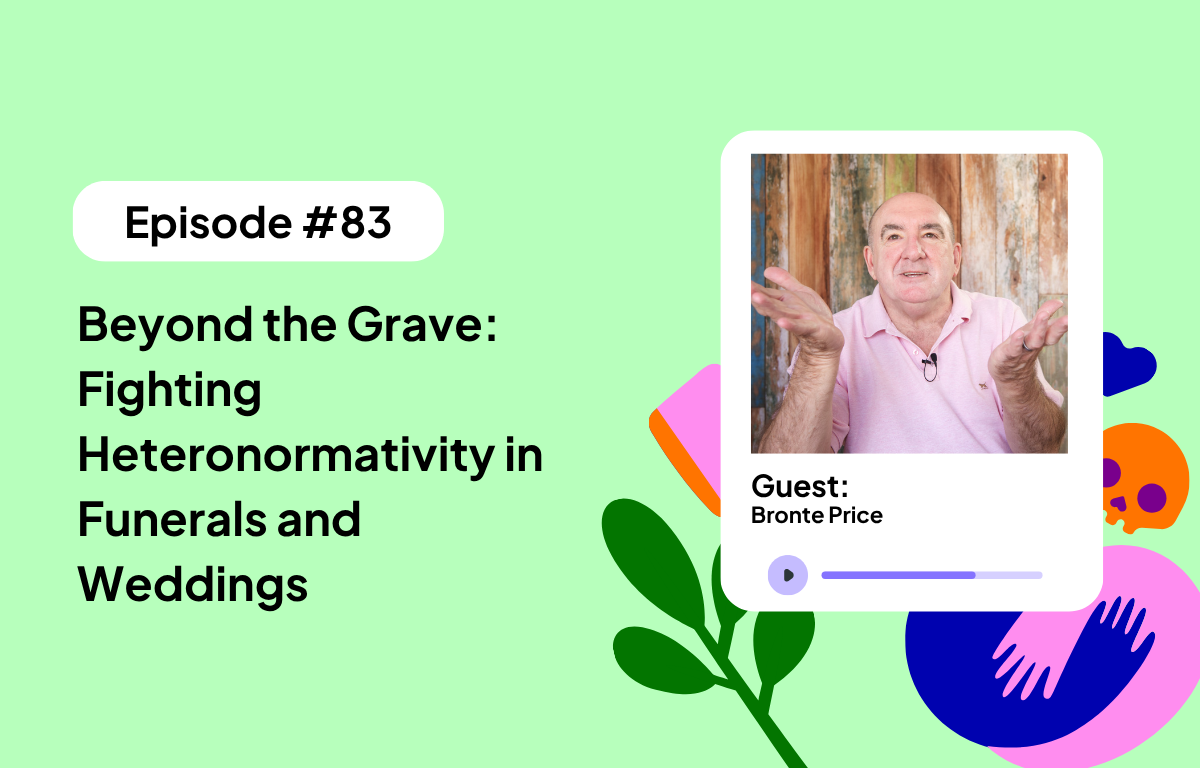Listen now
About this episode
Ever wondered if a simple box of fabric and words could unlock the toughest chats about dying? In this episode, I dive into the world of the Bioscope with Chetan Shastri, a Melbourne designer who's turned death into a navigable map – literally. It's not some dusty old chart; it's a tactile, embroidered toolkit that sparks real talk about end-of-life wishes, from home to hospice, without the awkward silence.
Chetan shares how his Indian roots, from street bioscopes with spinning films to his mum's hand-stitched embroidery, fused with global adventures in Cambodia's mass funerals and India's 'city of death' in Varanasi. Back in Australia, he wrestled with our hospital-heavy approach to dying, creating the Bioscope to decolonise death – reclaiming it from white coats and back to heartfelt conversations. We chat about his PhD journey, co-designing with palliative pros at places like Peter Mac and Alfred Health, and how this award-winning tool (shoutout to the Victorian Premier's Design Awards and Design Outlook) helps folks grieve, plan, and even cry it out at community sessions.
It's a reminder that facing death head-on isn't morbid – it's what makes life authentic. Chetan's work shows design can bridge cultures and taboos, turning 'the end' into a shared story. Check out images of the Bioscope in the show notes, and for a peek at those inspiring Kashmiri embroidered maps, head to the V&A Museum collections online – search 'Kashmiri Map Shaw' for a stunning look at cultural cartography.
Remember; You may not be ready to die, but at least you can be prepared.
Take care,
Catherine
Show notes
Guest Bio
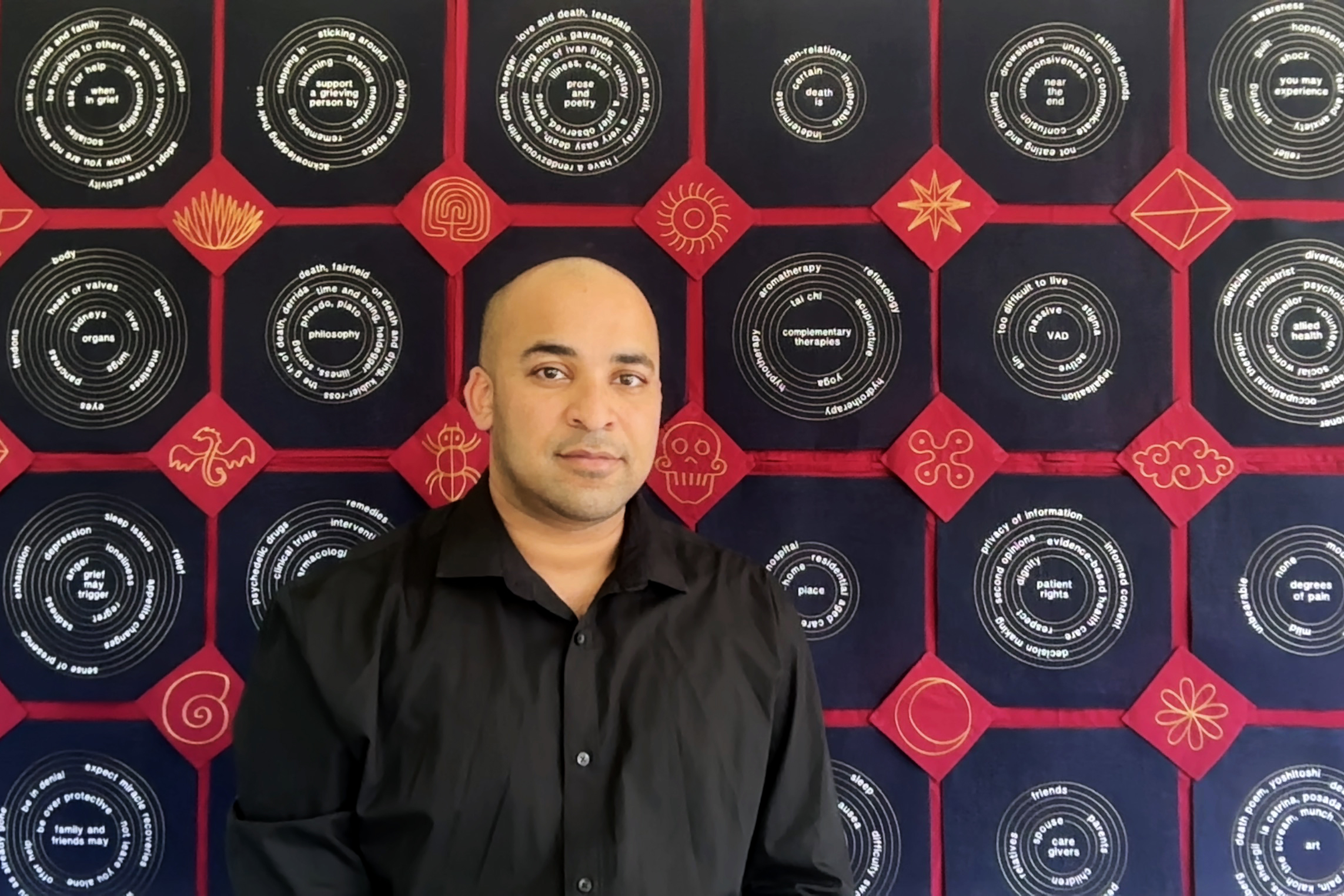
Melbourne-based designer and researcher
Chetan Shastri is a Melbourne-based designer and researcher whose groundbreaking work explores how design can support conversations about death and dying. Chetan is the creator of the Bioscope — an award-winning co-designed tool developed with palliative care practitioners to help facilitate meaningful, human-centered dialogue around end-of-life care. His work has been recognised by the Victorian Premier’s Design Awards and showcased at the Design Outlook Conference. With a practice rooted in empathy, creativity, and systems thinking, Chetan is reshaping how we talk about death — not as a taboo, but as a necessary, even transformative part of life.
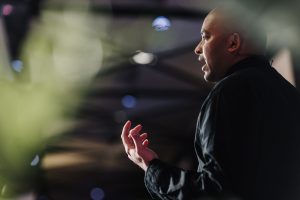
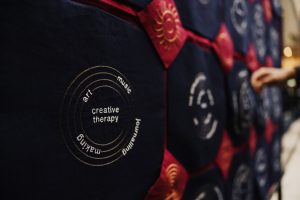
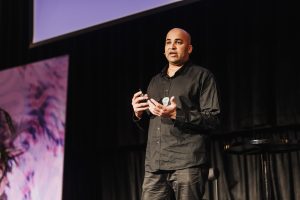
Summary
What you’ll hear in this episode:
- Bioscope origins from Indian cinema boxes to fabric map of dying sites like hospital and hospice.
- Global death rituals from Varanasi wood pyres to Cambodia delayed funerals.
- Decolonising death from medical control to cultural conversations.
- Co-designing with palliative experts at Peter Mac and Alfred, award wins and community use.
- Future plans for card/digital versions and custom Bioscopes in places like Japan.
Transcript
Chetan: [00:00:00] I think that death is more powerful than the sun, and it's a very deep truth. And I also think that it informs authentic living and it should inform authentic living. And what that also means is that in the past when we looked at the existential condition. And philosophers have mostly spoken about death, but it's also about existence. Catherine: Welcome to Don't Be Caught Dead, a podcast encouraging open conversations about dying and the death of a loved one. I'm your host, Catherine Ashton, founder of Critical Info, and I'm helping to bring your stories of death back to li ... Read More
Chetan: [00:00:00] I think that death is more powerful than the sun, and it's a very deep truth. And I also think that it informs authentic living and it should inform authentic living. And what that also means is that in the past when we looked at the existential condition. And philosophers have mostly spoken about death, but it's also about existence.
Catherine: Welcome to Don't Be Caught Dead, a podcast encouraging open conversations about dying and the death of a loved one. I'm your host, Catherine Ashton, founder of Critical Info, and I'm helping to bring your stories of death back to life because while you may not be ready to die. At least you can be prepared.
Don't be caught dead. Acknowledges the [00:01:00] lands of the Kulin Nations and recognizes their connection to land, sea, and community. We pay our respects to their elders past, present, and emerging, and extend that respect to all Aboriginal and Torres Strait Islander and First Nation peoples around the globe.
Today I'm speaking with. Chetan Shastri, a Melbourne based designer and researcher whose groundbreaking work explores how design can support conversations about death and dying. Chetan is the creator of the bioscope, an award-winning co-design tool developed with palliative care practitioners to help facilitate meaningful human-centered dialogue around end of life care.
His work has been recognized by the Victorian Premier's design awards, and showcased at the design Outlook conference with a practice rooted in empathy, creativity, and systems thinking. [00:02:00] Chetan is reshaping how we talk about death, not as a taboo, but as a necessary, even transformative part of life. Thank you so much for being with us today, Chetan.
Tha.
Chetan: Thank you, Catherine, for having me on your podcast. I'm very excited to be here.
Catherine: Now, can you talk through those of us who may not be familiar with what a bioscope is? What is it?
Chetan: Okay, so I can talk about this in many ways. So if I go off track, just put me back in. So when in India, bioscope has strong associations with cinema because we used to have, like this guy used to be called the bioscope.
Voila. It means the person who owns the bioscope or it's custodian. And it was like usually be a big box with lots of kind of scopes that you could look into. So he would bring it and set it up [00:03:00] and all the children would run to the bioscope while, and they'd probably pay him money and then they'd each get a scope like that to look into it.
Catherine: So like a kaleidoscope you'd look into, is that kind of y
Chetan: Yes.
Catherine: A box with multiple kaleidoscopes.
Chetan: Yes. And inside it he would have like a film and he would roll it like that. Oh wow. And then there would maybe, sometimes there would be a, like a gramophone and there would be sound and you'd see those images moving.
Oh, wow. And that's kind of the first impression of the bioscope and how before there were cinema halls. Even after cinema halls and theater, like film theaters, you would still have the bio who used to come for a long time.
Catherine: And so just, just explaining that, so there was a box and there was a series of holes that you could look through?
Yes. And what he would do [00:04:00] is he would actually turn the image at the top of the box. Yes. So you would be looking through the holes and you'd see. The image in a circular motion turning around Absolutely like a horse, you know, racing or something along that on a obviously a round dome. And so you'd see the image moving 'cause he was turning it at the top of a box using a handle.
And then there would be music via Agram phone that you would also hear as well.
Chetan: Yes, that's exactly.
Catherine: Oh, that's fantastic. I was just wanting to explain that because you were doing hand motions and sometimes hand motions don't translate well into the podcast, so,
Chetan: okay. Okay. Yes, so
Catherine: thank you.
Chetan: So, so that, uh, I associate the bioscope with, but, but in Latin, obviously bio is life and the scope is something to which you look, so it is like looking.
Through this thing, which I have made, and it's, it's actually, in terms of what I've [00:05:00] made, it's a physical artifact, just like the one on the back. But this was a initial sort of a Mac. Uh, this is one fourth of the actual bioscope. So like the bioscope has four parts. So this in its entirety would be one part, and then each of it has sites.
So. Like the bioscope all in its entirety is a map or a cartography. It is a map of death, actually. So it's a map of something that is intangible. So it, it's a terrain of death and then, but it takes metaphors from like. So it has sites on it, you know, like in a city you might imagine buildings at sites or in a desert, there might be dunes.
So it has those centric, which you can think of as sites. And then like each sites [00:06:00] has its proximity mapping. So all the concepts, uh, and ideas around, uh, concepts around one idea may be clustered. And then in its entirety, it's the study which has many sites and as a map of death and dying, you can use it to talk about it and explore that area.
Catherine: I've had the beautiful opportunity to feel and touch the bio because you've done a beautiful job of, you know, when most people think of a map, they think of it as in a paper form, and it has, as you were saying. Symbols for, you know, lake symbols for railways, symbols for roads. But what you have created is a beautiful artwork because it is a, in textiles, so you've used fabric, and then you have, as you said, the four different sections that form part of the [00:07:00] entire bioscope as itself.
And each of them are beautifully designed. Images or, or little icons that represent something different. So just looking behind you and we'll have images that the bioscope in the show notes so people can have a look at what we are talking about. But it is really beautiful. So just even talking me through perhaps, is that a little horse that I'm seeing behind your head?
Chetan: Yeah. Uh, it's interesting because this one, like I, I did the stitching and the zippers and like everything, but the app leak on the top and the embroidery on the right is hand done, and it's done by my mom. Uh, she has a background, like she was an artist, but then she taught fashion and textile design and, uh, design school in India four 20 or so years, and.
Director of a textile museum in [00:08:00] Cambodia and growing up, uh, Catherine like, because I would go to the university with her after classes or whatever, and then I decided that I didn't wanna be a fashion designer because that's how we were as like boys in two.
I wanted to be a sculptor actually, and I got into design and my kind of design was exhibition and space and structures and that sort of a thing. So although my mom was always working with textiles, I was always kind of never involved in it. But when I got an opportunity to go to the Victorian Albert Museum and the Royal College of Art to do my MA in history of design.
Like they have Indian collections in the Victoria and Albert Museum. They have objects more than 60,000 objects and out of that like [00:09:00] 17,000 to 19,000 are just textiles. And what was interesting, Catherine, is that I was working in as a way finding designers. So I designed like way finding and graphics and maps.
Signages and type and pictograms to the Bangalore Metro Mass transit system, which was the second in India. So it has like 85 stations. Each stations has three levels, 300 signs, and thousands of people pass through that space. So I was working Wow. Yeah,
Catherine: I can appreciate that. 'cause I, when I was at the Royal Botanic Gardens, I did way finding and interpretation, so I could only just imagine how much signage and wayfinding you must have done on that project.
Chetan: Yes, and and it was fascinating because I worked with a British company, a London based company called Transport Design Consultancy. And when I went to the rc, I was able to work with them again [00:10:00] simultaneously alongside my, and when you go into that way finding space, it's so kind of, is such a rational and scientific version of design.
So I was doing maps for like Network rail London and Tel Aviv and things like that. But. At, I was in the Victoria looking and they had exhibition called India, and in that exhibition. Maps of Kash and you can go online to the V Nna collections and write Kme Map Shaw and you'll get those beautiful map Shaws and they're hand embroidered maps of Kash.
And it's so interesting that my mom is in Kashmir at the moment teaching again and I, I mean, it's strange that like there is that coincidence, but I've never been to Kash, those maps kind of. You know, like then when I started thinking that [00:11:00] there's this template for way finding that, you know, we work with, and it's applied everywhere in, uh, Tel Aviv and Indonesia and India.
It came out from that London, London underground kind of work, which with the symbol and the maps. But then when you look at these kir maps, it just opens up your imagination to what like. Mapping in different cultures can be like, and I think when I came to Melbourne and I went to the Peter McAllen Cancer Center hospital, and Jerry, who was the director of Prevention and Wellbeing, she said that Satan, can you wave, find death?
Like I didn't do the set Peter Mac, we did an app. But at Alfred this happened. So like of course there are signages and there are guides, and then we can use Cartographies to way find that. So [00:12:00] this, this has, you know, that the cartography and the embroidery and the fabric. So it's, it's a very strange way that, you know, it's not quantifiable in terms of what those influences are Exactly.
That's how it came together. And Kashmir map is hand embroidered and these are hand embroidered on the back, but the bioscope is done on a Japanese machine. So it's a very different sort of, uh, making and it doesn't have iconography. Uh, such because, because that text is. Is important and like now maybe I feel more confident about iconography and visualizing death through images.
But at that time I think it was a strategic and very, uh, risk averse choice to use text on the,
Catherine: that's really interesting. So let me just take [00:13:00] us back a moment. So you are working. With the VNA, you know, in London you are working on, you know, railways and, and the underground and mapping that. How did you end up in Australia working in with palliative care?
Chetan: I think that is also. Uh, be because I think I was not sure of what I wanted to do, Catherine, so I was like doing things and when, when I did exhibition design, I decided that I wanted to do museums and I thought that is meaningful work for me. Then after London, I started teaching in India and like I've, I've done two masters and then like.
The PhD and I have been teaching, so I've had like this strong kind of relationship with academic settings as a student, as a teacher, as a researcher. [00:14:00] And I wanted to do a PhD because I wanted to be in the university settings. And it seemed like the next logical step. And at that time I wanted to do my PhD on the history of.
South Asian material culture, and I went and had a first conversation with my then potential PhD supervisor in Barcelona from London in 2017, and we were talking about either building a project in a prison. Around food or in palliative care with through conversations, you know, like the health and design is like a emerging space.
And through those conversations we said that, okay, the palliative care project makes sense. And that time my supervisor also had a project at Austin Hospital, but by the time I get caught funding and I came to Australia's project was done. So we were able to reframe it in certain ways because I didn't have healthcare.[00:15:00]
So we said that then what does it mean to Decolonize death? So then basically unpacking and deconstructing it and seeing what it means, uh, how we can unpack death is how we started with it. And that because of my work at the VNA and South Asian Material Culture, that was a easier switch for me to make to see that.
Decolonize that idea culturally or unpack it culturally is how I kind of begin to grapple with this.
Catherine: And so tell me the term decolonizing death for someone who's totally unfamiliar with what that means. Can you talk us through it, please?
Chetan: Yeah. Yes, of course. I think, again, there are many ways to talk about it.
I no longer talk about it as decolonizing. We kind of talk about it as de death [00:16:00] or kind reclaiming death from the hospital, but they kind of one and the same in terms of, you know, more traditional and cultural ways of thinking about death and dying. And in terms of like now deaths being colonized by the hospital and mediated by.
Clinicians mostly. So in that way, like losing the ability or the confidence or the sociocultural knowhow of dealing with death or by talking or being able to talk about it is, and like Paul Fairfield and his book about. Death. I think there, Paul Fairfield very nicely talks, and I can quote him, but I don't have the quote right here, but he says that like in the hospital, the death is mediated by the clinicians, but they're not interpreters of the human [00:17:00] condition really.
Right. So the priests of the past have been replaced by lawyers and administrators and. Technical in that sort of a way. So I, I mean that that debate and that conversation and that understanding of what the medicalization of death means is quite strong and profound in Australia already. And yeah.
Catherine: Yes, I have many, um, people who I've interviewed and we talk about that.
At one stage in Australia, there was a room dedicated in even architecture and design. You had the, the parlor at the front of the house, and that would be where you would have your loved one laid out when they had died, so people could come and actually pay their respects and honor that person. And then at the sort of turn of the century.
We actually saw that shift where, you know, people [00:18:00] no longer were using the, the parlor and then it became a more of a medicalized process. So it's certainly something that will be familiar to the, the listeners of the podcast. So. You find yourself in Australia and you are working with the one at the Austin had finished That was right.
The project by the time you'd arrived? Yes. And then how did you introduce this concept and tell me, tell me how it developed over time.
Chetan: Oh, so I, I can build from, uh, we at SOAP in Britain and Australia there was the parlor, but what happens? You know, in India for example, or in Cambodia and like as soon as I came here to Australia, it was September, and then of course the university kind of winds down November, December, January, we come back in [00:19:00] March.
So I was able to go home to India. I connected with her. Like a non-government organization called Cancer Support, and they let me go on rounds with a nurse and with a counselor. To patients. So in India we have like public health and private health and the social sector. And the social sector does a lot of the work also because they're funded well.
So it is otherwise, it's largely private healthcare because the public healthcare infrastructure didn't really grow very much after the British left or did not grow as well as it should have. And then, um, with this NGOI was able to go and visit patients, so they would visit like seven patients in a day.
So I, they said I can go for two days, so I went for around one [00:20:00] and a half days and like, uh, those were my first experiences of meeting people who were. Recover. Palliative, they were their homes. These guys would meet at the office in the morning, the nurse, the driver, and the counselor, and they would take some morphine in the back and go to each of the houses and an an hour, one hour, and then drive to the next place.
Uh, so like that it was about seven patients. I also, uh, went to 10 patients because one and a half days. And then I also went to a hospice called Hospice. So it's run by Christian missionaries and it's free. And they have quite a few beds, like 20, maybe even 40, and they have like a nursing station in the center and beds all around.
Only two or three beds are occupied because in India, [00:21:00] people wouldn't, would normally like to take care of like their family at home. And there is stigma and taboo kind of. Other people would say, oh, you left your mom to die in that hospice. You know, even though there's better care and support that they would get that.
And o over time, like friends of mine, I've recommended that place and they've taken their parents there, so e even people don't even know that it is there. And then after that I went to va, which is a city of death in India. So it's, that's more of a culture space. But of course everything the burning and happens on the two or three carts that are there, the too prominent.
Guards are there, which which are burning bodies around the clock, 24 hours, always a couple of fires burning there, and they burn with wood. Their electric crematorium also there, but people [00:22:00] prefer to use wood and they use like 200 to 500 kilos of wood. And like there's a very interesting, wow,
Catherine: that's a lot, isn't it?
That that's
Chetan: a lot. And like if, if people don't have money, they like villages further up. The ga, they just put the body. So sometimes you see a body floating around. The equally content in the gang is like way above. Recommended like 400 times or something like that. And, and there is a place, a philanthropic sort of a setting called where people can go for the last 20 days of, uh, days of when they're about to die and stay there.
Because in Hinduism we believe that if you die.
You liberated of, and so you'll [00:23:00] be free suffering after this kind. So everybody wants to die in Kashi, so they're death hotels. So people when they're 60, 65, 70, they come and stay in some little room in Kashi waiting to die so that they can die there. And in this place, people will travel from far away to come and like spend their last days when they know they're dying and they don't charge anything but a little bit for electricity.
A dollar and, uh, they let you stay. They let your family stay there. So I took my GoPro and I was able to kind of shoot these things. I thought I'll make a film. And then after kind of, so I was just going and looking at that and what that might mean and what happens because I don't have a healthcare background.
And then I went, my mom was in Cambodia, like I mentioned, at that museum as director, so [00:24:00] it was like an Indian government coast thing. And so we would go and stay there. That was my third visit to Cambodia and we would drive, and then we were able to. Like she had also shot before some ceremonies because in Cambodia, what.
People do in villages if they're poor, like if they someone dies, they bury the body, wrap it up and bury it. And then when there are seven, eight people and they have enough money, then they'll organize a big funeral. Then they'll pull out those bodies so she capture one of those mass funerals. But if you're driving in Cambodia, you can see a white flag.
It's crocodile flag flying and wherever the crocodile flag is flying, someone has passed. And uh, it's the Buddhist monies that are there. And so I was able to shoot on video of two monks, [00:25:00] so then extremely to the royal families. So the entire community organizes those ceremonies and they are fascinating.
Like, uh, so there, there is a lot in, in that conversation in Cambodia and I have like quite a few hours, like maybe four hours of footage, so to edit it into a film. And they have practices like, uh, and you know that of course that there was the common roots, so. They have the killing fields and things like that, so there's a lot of death tourism there.
So and so that Chinese funerals, they're Buddhist funerals, they're the funerals of the monks. They're the funerals of the poor people. And they don't have healthcare. They have healthcare decide only for the expat. So often when someone is dying, that journey is also mediated by the, and that is. Great or healthy, but it is [00:26:00] in contrast to healthcare.
So when I came back to Melbourne, I wanted to make a film. They said good ethics. So we said, okay. So we said, let's try retrospective ethics. So with PR started building it, but after a point I realized that maybe doesn't make sense to do that retrospective ethics. So then I started looking at what makes sense to do in Australia, and then it became very obvious because there's a healthcare or emphasis on healthcare and.
There's the hospital. So said, what can we do about death in a hospital? And like I got introduced to people in Peter Mac and at Alfred, and that kind of opened up. But then the pandemic also happened, just, you know, when I came back. So that's September, October, February. We were in Cambodia and there [00:27:00] was all the bushfires and then, yeah.
Yeah. So we came back early and then was okay to be able to build that project through the pandemic. It shifted like engagement to online modes, but I sort of. I also learned and benefited from that because, yeah, you plan it for a physical setting and then you decide that doesn't work, so you do it online.
And then when things opened up, I was able to go in. Person. So yeah, that sort of happened.
Catherine: And so tell me, when you were going through this planning process, what was it you saw, obviously from your own heritage in India, what you'd seen in Cambodia, what you'd seen to your visits, to Nessi? When you were sitting there thinking about, okay, this is the, an Australian [00:28:00] context, what were you planning or what gaps had you seen where things were done overseas, where you had identified perhaps gaps in a, in the healthcare in Australia that you thought that the bioscope might be a good tool in which to have these conversations?
Chetan: There were like. Not, not really gaps, but it was like a matter of framing. Like there was like, because of all that culture and stuff, I would look at a lot of after death practices and like that space is like now we are doing the studio at Monash Design for like dead and dying and grief. Students are also kind of gravitated, gravitate towards that because like that access to the hospital is not there.
Like it's gm. CT is more [00:29:00] accommodating and they'll, you know, do a tour and let them see everything and, and speak to doula or go to a funeral home. Talking to a clinician is difficult and problematic, and there are barriers to access. So that that space of like how do other cultures do barriers and, you know, those things become more fascinating.
But then it became like a broader framing to say. Like, so what? What are we doing? So we maybe I'm not doing after death, and then one is doing and then death maybe for a long time, like no, death does not exist. So then it is not death. So then we are doing dying and we are doing. Palliative care. Even within that, it is not another person that you're looking at the experience of a person who is [00:30:00] dying.
And then of course it has other sort of side effects or you know, it lends itself to other things and it has transferable qualities. But then the idea and the framing was to look at how to support. The experience of a person at end of life, and that's kind of where it began. So, and then it was about navigating death and dying.
And when Jerry said that. At Peter Mac, she said, look, we, we want to do something so that a patient, and she j Jerry or is not at Peter Mac again. But like I said, she was the director of prevention and wellbeing and, uh, nursing background and very encouraging and, you know, worked closely with the doctors and a lot of innovative work she was doing in that space.
And [00:31:00] probably continues to do that where she's a adjunct or associate professor now. So Jerry said that, let's do way finding death. And I, I think she was digital in her, and that's, that's kind of what is happening in hospitals because there is technology. And they're technical and they see that technology can do things, and those are the narrators that come from design thinking and innovation and startups and funding, and those cultures are built around building.
Some sort of a digital innovation, so,
Catherine: and something you can do at scale. Whereas something that, you know, I love about the bioscope is the fact that it is something that you can sit round a table, you can touch, you can, you know, move the pieces around to talk about it. And it is such a, a physical, tactile experience.
[00:32:00] And that's, I think, part of the beauty of what you've created.
Chetan: Yeah, maybe I digressed from that answer to working in the hospital, which yes, the Death Cafe and at Peter Peter Mac, I was able to attend a Death Cafe by Julie Hassard and she facilitated it. That was my first death cafe, and there were clinicians and patients and volunteers, and I think that and my own thing of finding, you know, like.
I'm after death practices, I'm mapping them and putting them down. I'm looking at re So this became like a collection of lots of ideas and suddenly that collection of ideas, you know, you could put it out in a death cafe and talk about. Those things. And like even in design, there are kind of these ideas, right?
Like if you do co-design, you need a toolkit or a visualization and service design to engage [00:33:00] participants. Or in the resource mapping, you make a drawing or someone makes a cultural probe to insert into another context too. Read it. So these sort of, and of course way finding, so that, so that, that's sort of how that bio framing came and.
Yeah.
Catherine: And tell me when I, I look at the bioscope you've seemed to have collected. I'm, I'm just reading from a couple of the panels now. So, one panel, it's set with a, a series of words in a series of circles. So the first one on the outer circle is hospital. Then the next one is hospice, and then residential aged care home.
And then Place?
Chetan: Yes, so, so the one in the middle. So normally we read [00:34:00] from Inside out because the one inside the circle is the name of the site.
Catherine: You can tell I haven't read your instructions, Jayden. Sorry. Sorry. No
Chetan: instructions. No, no instructions. Maybe I should make that. Oh,
Catherine: there you go. That's interesting that it doesn't have instructions as well.
Chetan: Yeah, maybe I should make, but, but the title of that site would be placed and that, but we, we didn't want to use that on the bioscope in the beginning because that, that can be, that is taboo. Right. So
Catherine: yeah,
Chetan: so it would go to all these gray areas and then when you go and talk to the doctors, they say, of course you can use it.
You have to use it. So then it becomes normalized. But there are many gatekeepers and custodians and we, it's shared understanding. Some places, some things are okay. Like in the church, we cannot talk about voluntary assisted dying. Maybe in the hospital weekend. So [00:35:00] that, that happens a lot. But this specific site was one that we tested with the doctors and we built it with them.
So, uh, the first workshop had two sites. There was this, uh, and the site called, which had first called alternative therapy, but we changed it to complementary therapies. But this specific site, I'd like. 12 or 16 things. So this was place, and so where should we die? Where can we die? Where would we like to die?
And when you put a site in front of the doctors, you'd ask them. So what does this mean? And like, how should it be? So they would unpack it and they, I have things like die on a beach, and then they would say that, that sounds like a really nice way to go, but in all probability it's not going to be possible.
So the four very realistic alternatives that we have, uh, is that you can think about dying at home. [00:36:00] Or the residential Asian care in a hospice, with the sense that Australia does not have a huge culture around hospices. It may be more a American thing or in the hospital, and that's how this site took shape.
And then based on these first two sites, like I went back to my literature. And then so all the cancer care booklets and that that vocabulary which the doctors use and that is there in the Cancer council booklets is it really maps exactly onto each other. So a bit of the bioscope became very cancer.
And then we had to rework it again to make it that centric.
Catherine: And so tell me, it obviously, you know, like for someone who's done a SaaS platform, so you know, an online cloud platform and, and has gone through two years of developing that, I know that there's many [00:37:00] iterations, many conversations, many feedback.
It sounds like the processes has been exactly the same with the bioscope. So. What sort of version of iteration are you at now and what are your future hopes for for the bioscope to be used?
Chetan: It's a tough question. Like how, how you put critical info together so quickly is very impressive category and like after coming out of the hospital, making the bioscope and having like the first thing was pretty conclusive for me.
Many ways. And then I imagine that different hospitals would commission it. So like making a bio in Japan would be fascinating. You know, like two languages or visuals and that idea.
Tension between modern and tradition. So, or if I were to go [00:38:00] back and make one with the pan care guys in India can support guys in India. And so it can have many versions. And if I made one for Peter Mac, it would be more cancer centric. It would have different colors. It may not, not just colors, it may have less type, it may have more visuals.
It may be in ceramic tiles. And all that sort of a thing. But unfortunately that has not yet happened. But, but maybe it'll happen. But right now this is my bioscope. So when someone says bring it, I take it. So right now, Karen Brady has it because we are doing like dying to know they thing like you did at that library.
We doing it at in me
later. So that, that is where it comes out. But I, I'm working on a set of cards. I don't [00:39:00] even like to say I'm working on it because I've been doing it for, that's a long time now that it's not kind of, but, but I think there, there will be versions to it as cards, as, as maybe a digital thing, maybe just another, because I enjoy the making of it.
So if someone says, Steven, can you make me one? But, but I think it's also because. I haven't transitioned out of my PhD. Well, like I, I worked like a mercenary, now teach one course here, teach one course there. But if I'm in India or Australia, I don't know where I'm, if I have academic position, some funding, some PhD, some association, some sort of.
Maybe NGO who wants it, you know, then I can apply myself back to that again and then co-design it with them again in a different language. Take it, use it with the people in a different format. So,
Catherine: and tell [00:40:00] me. You know, it's obviously your work and the, the way the bioscope is used as a tool to to have conversations has been recognized by the Premier's design awards, and it's been featured in the design Outlook conference.
You know, what did you find when you were working with those particular groups? What were the things that sort of came up when they were working and looking at the biosphere? How did you find that it was assisting people as a tool to have those conversations?
Chetan: Like, like the Premier's award is more sort of a application and you put in the images and the text and they read it and they, they say, well, maybe this isn't, and uh, there's, she's there.
She, she has T toolkit, so there's a precedent. In this space, and I'm not a very sort of a person, I just sort of put it in there because [00:41:00] students can put it in free and uh, became a finalist. But then when I was sitting there, I was embarrassed because younger people should have. When I, what we stated, so maybe I should have put it, paid some money and put it in the service design category or something.
So
Catherine: don't ever beat yourself up or sell yourself short, you know, like, yeah, we, we, we always are too quick to do that. So, you know, it's an amazing achievement to actually be recognized in an award regardless of whether, whatever category it was. Yeah. Obviously, when you put your application forward. There was some, you know, it was recognized by your peers.
So tell me about, you know, when people interacted, what did you find that they were getting out of the experience? Were using a bioscope,
Chetan: so, so that response is kind of slightly different. So with Premier's award, there [00:42:00] wasn't that kind of exchange at the design outlook. Conference conference, there was feedback because there were a lot of designers and then they said that, well, they would reach out and we would talk about it.
So there was a bit of networking and they, uh, the design outlook is like a very glamorous industry sort of a thing. So this sort of a work would be unusual in that setting. So I think most of the responses. Related to that, but I think where people really respond to the bioscope is when I take it to my local library, which I have been doing, and I did like three sessions there.
And the first time someone was sitting and looking at her and she started crying and we were talking about it. And then when I went back I thought that, well, what [00:43:00] kind of a thing is this that it kind of makes people. I cry. But then I think over time, next time I walk by, she smiled and wave because they have the woman's knitting group there.
And I think she needed to cry and you know, she needed to talk about that. And I think that is what happens. And people talk about what they need to talk about. Like some people talk about, uh, grandchild to leukemia. And then how about that child being in the house even after passing away and then like, you know, other worldly experiences and other people might talk about how they didn't get along with their mom and that sort of a trauma.
If a friend of mine came home and she's a textile artist and she exhibits in Ballarat, and so. [00:44:00] Showed her the bioscopes on the wall and she didn't say anything. And I said, she's a textile artist. She would respond to the textile and for a while she didn't say anything. And then she suddenly talked about how she lost her mom six months back.
And then when I was making it, two ladies with a baby came up and they were interested in the embroidery. And they asked me what it is and I told them like how I turned it, like a cushion cover and everything. And then they said that she lost her husband and one child and you know, so they didn't, probably didn't come to see it because of the embroidery at all is what?
So it, it draws in people in different ways. Sometimes people are dismissive of it also, so all sorts of stuff happens there.
Catherine: It's very powerful that someone can see. And you know, you could call [00:45:00] it the a bioscope, but. I view it as a beautiful piece of, of artwork, like it really is. And for that to be able to evoke emotion and, you know, prompt conversation and open conversations about, you know, really deep things really quickly.
That is a rare thing in this space. 'cause that's, as you said, you know, our culture in Australia is, is almost death adverse and it is a taboo subject as you mentioned. So. It is a very powerful tool that that is something that it can do.
Chetan: Thank you. Yeah.
Catherine: And so what does it mean for you, given the fact that this is such a culmination of you really in an artwork.
It has your, the heritage of your mother, so much of yourself, and then you also have your son. So is this a legacy piece for you? How do you view it?
Chetan: [00:46:00] It's very interesting that you asked that because it connects back in ways so. Well, when I did my three workshops at the local community center, then Liz, who's the manager of the Thomastown neighborhood house at, didn't you do more, uh, throughout the, but I didn't want to do like one every month or every two weeks with the same people.
I wanted to do, make a new sort of a thing. So then my wife is also doing her PhD in diabetes and obesity, self-management of that. And it broaden out that it's not just like you can't look at illness in, so it's more about wellbeing and care of the self and like then we said like it's about life and that.
So she's now done. Five workshops with those people to talk [00:47:00] about care of the cells. So they talk about food one day, about exercise one day, and like mom makes a lot of things with hands, you know? So like for me, doing this in the PhD was a very transf experience, which means like confronting a lot of stuff for myself.
I realized that it is closely tied to mental health in some ways, and I, I think I'd, I'd like to make one for, to talk about other issues, psychological ones if possible, and in the design space, Catherine has become like a methodology in some ways. So like, my honor, students can do projects in depth and I can support them.
Through that, and someone just worked with Carly at Green Heaven and she's designing something to take a Miss [00:48:00] Baby home from the hospital, which is otherwise sent in. Was it locked back? So by being able to support that student in that journey. But also it now allows me to work with people with, uh, disability.
So in Monash we built a project with Makers and where we design for short term accommodation, so that kind of transfers into service design for health. And this semester we are doing design for death and dying, and so many other projects in the design for death and dying space are emerging. But they're also transferable spaces.
And like out of all the things, it was this World Futures Review journal. I published an article and at the Design Outlook conference I was like, as a witty thing, I was saying that [00:49:00] this is a user journey from birth to death. And that sort of has become my model for design that like. I would like to design for the two main life events, birth and death for a practice of care between birth and death.
And that doesn't mean designing for healthcare only, but it also means designing with care because that can become important in some contexts. And then for the person's relationship to society and to ecology. So. I think death has also informed. My design space a lot.
Catherine: Jayan, I think RMIT are very lucky to have you leading their, their students along the way to hear the example that you just provided about one of your honor students working with, you know, in, in practical application of actually supporting a funeral home to support then a [00:50:00] family.
To have something, to, to take their their baby home with that is pretty phenomenal.
Chetan: That's all El, her name is Ellen Wong. And, and that, that's a very promising project and I think some ways that Victorian Premier was also helps. We have, like, I hope she'll submit one and win one. And you know, at Monash also there was a very beautiful project, which Mina Aula and Sarah did, you know, and Mina's brother is different.
So she was very motivated to work on it. And, and Tom has published it. Mary States has published it on online, but she's also submitted it for the good design. So, and, and Catherine, it's so amazing that, you know, like in Monash when you put out like it's an elective. So students from all disciplines and so [00:51:00] many of them really wanna work in this space and they really come up with like so many different ways of looking at it, which is very, very nice and exciting.
Not be limited by our own imagination.
Catherine: And tell me, Satan, when you have been working on these projects and you spanned numerous countries and then different audiences with who you've worked with, with developing the bioscope and now the work that you do with, you know, lecturing and and mentoring, tell me is the work that you do and the focus about death.
Is it more about life? Because it was interesting, a topic, a thing that you mentioned at the very start when we started talking about that, when you were working out which area to type, try and focus on. You were looking at after death rituals to start off with and thinking about that. And then you said something along the lines of death.
Well, death is [00:52:00] just death. And I thought that is, that is exactly it is that death is death. There's not much you can do about it. It's, that's a kind of like a void, but it's everything you do beforehand or everything that you do after that particular point. That is the deciding factor in how people respond to that death.
Would you agree with that?
Chetan: I think that I, I would cat in absolutely. And. Like we don't always have the vocabulary to talk about it, but that many people have said it. And that artists in London also put that artwork during the pandemic. And to say that you cannot stare at death or at the sun for too long, and I think that death is more powerful.
Than the sun. And it's a very deep [00:53:00] truth. And I also think that it informs authentic living and it should inform authentic living. And what that also means is that in the past when we looked at the existential condition, and philosophers have mostly spoken about death, but it's also about existence. And that the two are tied so closely and religion gave us narratives towards morality and authentic living and what is right and wrong.
But then with kind of the colonization of death by science, by modern medicine, I, I think that the rational way of thinking. It does not always kind of, it doesn't have the tools to look at ethics or morality or relationship to equality like the [00:54:00] indigenous people have that kind of, you know, that relationship with land.
And so I think death can become very central in that sort of a way because even with design. Or not designed for people, but I think that designing for people and being conscious that of the temporal nature of life and its relationship to the ecology within which it is insert, we are inserted, becomes very, very important.
So not entirely rational, not religious or cultural in that sort of a way, but as a deep truth. It can really help us like. Throw us things then as a point of reference, just like the sun. So yeah, it's just, it's not a play on that metaphor really. But I think there is something to that.
Catherine: Jayan. I can't thank you enough for [00:55:00] spending time with us today and, and just developing.
Or creating, I should say, such a beautiful, you know, roadmap and in the bioscope to really help us navigate the really challenging conversations that are around death and end of life planning. And it is just a beautiful artwork and a beautiful tools. So thank you.
Chetan: Thank you very much, Catherine. I really enjoyed it.
Thank you for having me on your podcast.
Catherine: We hope you enjoyed today's episode of Don't Be Caught Dead, brought to you by Critical Info. If you liked the episode, learn something new, or were touched by a story you heard, we'd love for you to let us know. Send us an email, even tell your friends, subscribe so you don't miss out on new episode. If you can spare a few moments, please rate and review us as it helps other people to find the show.
Are you dying to know more? Stay up to date with. Don't be caught dead by [00:56:00] signing up to our newsletter and follow us on social media Head to Don't Be Caught dead.com for more information and loads of resources.
Read Less
Resources
Resources & links mentioned:
‘An Aesthetic for Death’, World Futures Review, 2025
‘Design for Death and Dying’ (presented at Design Outlook 2023, Melbourne, Australia, November 2023)
Australian Death Studies Society, Creative Work Prize for the Bioscope Project, 2023
Victorian Government, Bioscope Project Finalist—Victorian Premier’s Design Awards (Student Design Category), 2023
PhD Examination Presentation, October 2023.
Chetan's social media handles are:
Instagram: @shastrichetan
Facebook: https://www.facebook.com/chetan.shastri/
LinkedIn: https://www.linkedin.com/in/chetan-shastri-25747718/
- Make Death Admin Easy with The Critical Info Platform
A simple system to sort your personal paperwork for when your information becomes critical.
- My Loved One Has Died, What Do I Do Now?
Our guide, ‘My Loved One Has Died, What Do I Do Now?’ provides practical steps for the hours and days after a loved one's death. Purchase it here.
- Support Services
If you're feeling overwhelmed by grief, find support through our resources and bereavement services here.
- Support the 'Don’t Be Caught Dead' podcast with a one-off or regular donation to help Critical Info, a certified social enterprise, keep creating free, high-impact conversations about death, grief and planning—every contribution fuels our mission to reduce the burden on families and build a more death-literate, compassionate community. Donate now.
